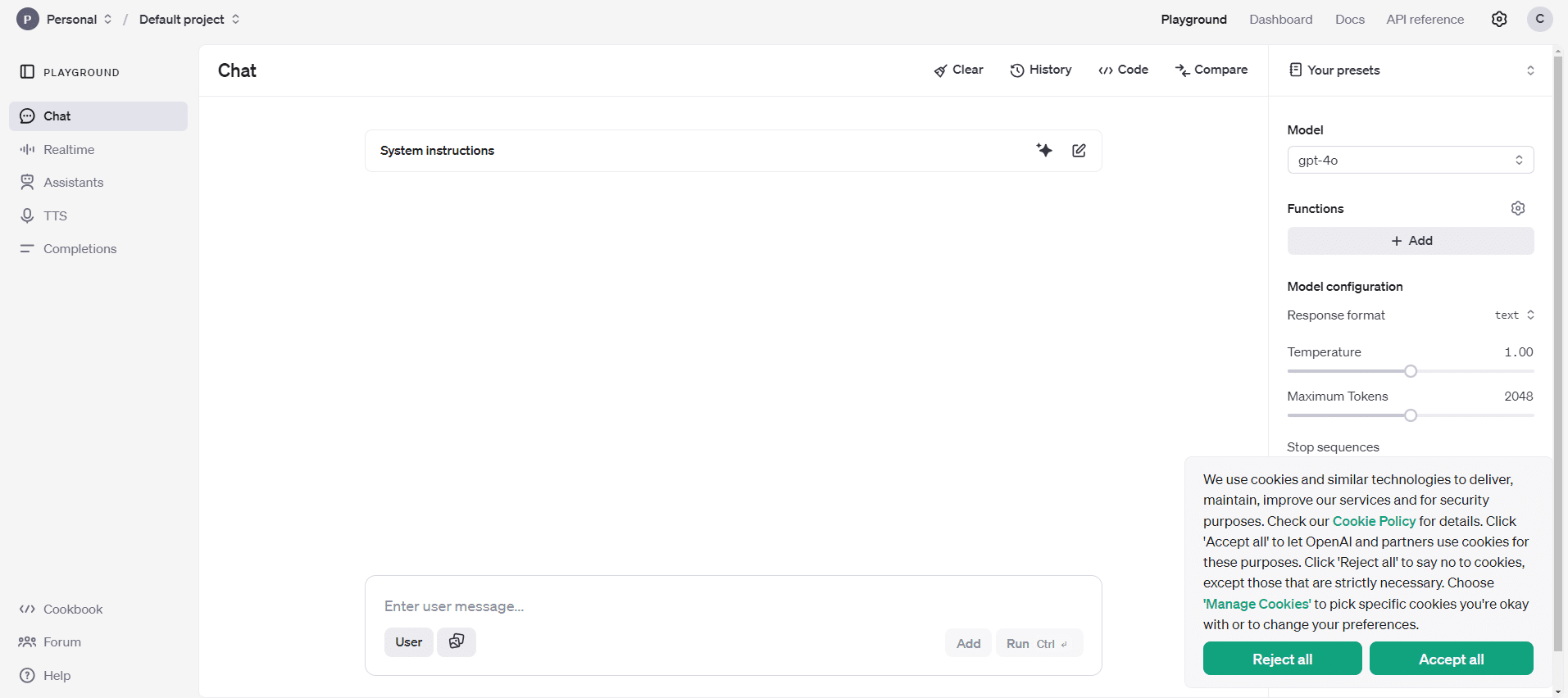The OpenAI Playground is a powerful tool offered by OpenAI, distinct from the ChatGPT website, that gives users greater control over their interactions with ChatGPT. It provides access to various AI models, including the latest versions like GPT-4, as well as earlier models like GPT-3. This platform is specifically designed for those who want to delve deeper into AI’s potential, offering the ability to experiment with different language models. Users can customize their prompts, tweak model settings, and leverage specialized modes for specific tasks, making it a valuable resource for developers, researchers, and AI enthusiasts looking to explore the full scope of conversational AI.
On This Page
How to set up the OpenAI Playground:
To begin using the OpenAI Playground, visit http://platform.openai.com and sign in with your credentials. Once logged in, you can start experimenting by testing prompts and exploring the various AI models and their responses.

OpenAI Playground Interface
At first glance, the OpenAI Playground interface may seem complex due to its many dropdowns and sliders, which allow users to customize models to their specific needs. Key features like Mode, System Prompts, and Model selection provide advanced customization options. By fine-tuning these settings, users can greatly influence how the AI responds, making it adaptable to various scenarios or questions. This control is especially useful for those interested in exploring AI’s full capabilities, offering a sandbox environment for experimentation and learning. In this lesson, we will cover Mode, System Prompts, and Model selection, while LLM settings like Temperature, Top P, and Maximum Length will be discussed in the next lesson.
OpenAI Playground Modes
The Playground offers different modes under the Assistants dropdown. To change the model type, click the Assistants dropdown at the top left of the page. OpenAI provides three modes: Assistants, Chat, and Complete. We have already covered the latter two. Assistants models are designed for API use by developers and can use advanced tools, like running code and retrieving information. For this course, we will focus on Chat models, with occasional use of Complete models. Exploring these modes gives users hands-on experience with AI’s wide-ranging capabilities, from casual conversations to complex problem-solving, demonstrating the versatility of OpenAI’s models for various applications and user needs.
OpenAI Playground System Prompts
Once you switch to Chat mode, you’ll notice the SYSTEM section on the left side of the page, along with the Get Started popup. So far, we’ve seen two types of messages: USER messages (your inputs) and ASSISTANT messages (the chatbot’s responses). A third type, the system prompt, can be used to influence how the AI responds. By default, the system prompt is set to “You are a helpful assistant.” However, you can customize it, like using “You are PirateGPT. Always talk like a pirate,” from our previous lesson. Experimenting with different system prompts allows users to personalize the AI’s persona, creating unique and tailored interactions for specific tasks or scenarios.
Model Dropdown
To change the AI model you’re using, click the Model dropdown on the right side of the page. Each mode offers multiple models, but we’ll focus on the chat models. The list of models may seem complex (e.g., what does “not-3.5-turbo” mean?), but these are simply technical names. Any model name starting with “gpt-3.5-turbo” refers to a version of ChatGPT. While those starting with “gpt-4” refer to OpenAI’s newer GPT-4 model.

Note:
You may not see GPT-4 models in your interface.
The numbers like 16K, 32K, or 128K in the model names represent the context length. If no number is listed, the default context length is 4K for gpt-3.5 models and 8K for GPT-4 models. OpenAI regularly updates both ChatGPT (gpt-3.5-turbo) and GPT-4 models, and older versions (which are marked with dates like “0613”) remain available for a limited time. For example, “gpt-3.5-turbo-16k-0613” is a ChatGPT model with a 16K context length, released on June 13th, 2023. It’s generally recommended to use the most recent models, which don’t include dates in their names. A full list of available model versions can be found here.
Conclusion
The OpenAI Playground offers a robust platform for interacting with AI models, providing users with extensive tools for exploration and experimentation. Its customizable settings and variety of models make it a powerful resource for understanding the full potential of AI. In upcoming lessons, we will dive deeper into additional settings and their practical applications. This makes the Playground an essential tool for both beginners and experts in AI exploration.
